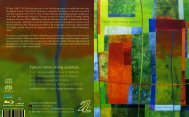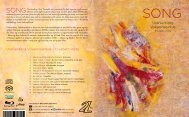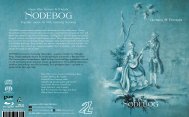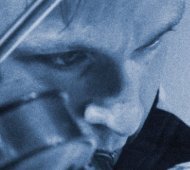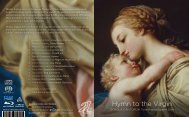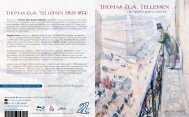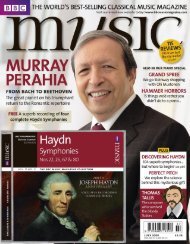Create successful ePaper yourself
Turn your PDF publications into a flip-book with our unique Google optimized e-Paper software.
Is this a shallow, eclectic composer, blindly following musical fashions? Most definitely it is not – Nystedt has<br />
adopted and integrated all his musical impulses and influences in his own, distinctive musical idiom. Those who<br />
believe it difficult to ”understand” twentieth century modernism, should start with Nystedt. Many music lovers<br />
find it difficult to approach avant-garde music, frightened away, perhaps, by terminology such as ”dodecaphony”,<br />
”aleatory”, ”mobiles” and ”tone clusters”.<br />
It is true that these elements may also be found in Nystedt’s scores; his musical craftsmanship, however, is<br />
so superb that one never really notices the composition techniques in themselves, they are simply part of his<br />
natural, organic music-making. Whether writing in a traditional or modernist style, Nystedt’s music has a strong,<br />
instinctive musical feel to it.<br />
Seventy-six years’ experience is all well and good, but it is the quality of the work which counts. And let it be<br />
said: Nystedt’s music anno 2003 has retained its vitality. The title of one of the works on this recording is highly<br />
appropriate: Nytt er livet (New is the Life) – listen to the wonderful fountain of sounds the composer releases at the<br />
words ”ein foss av lyd” (a waterfall of sound).<br />
Spenningens land (Land of Adventure) is the title of an early work for orchestra by Nystedt. And it appropriately<br />
describes Knut Nystedt’s life work – a land of adventure.<br />
Track 1-6 Prayers of Kierkegaard opus 157 for mixed choir 17:42<br />
was composed in 1999. It was commissioned by The Norwegian Soloists’ Choir for their fiftieth anniversary. The<br />
first performance took place at Oslo’s Jacob Church on 18 November 2000, performed by The Norwegian Soloists’<br />
Choir under the leadership of Grete Pedersen.<br />
1st is an excerpt from a discourse on John 10, 27 published in Taler ved Altergangnen om Fredagen (Addresses at Holy Communion on Fridays) (1848). 2:28<br />
2nd is the opening of a discourse on 2 Timothy II, 12-13, published in Taler ved Altergangnen om Fredagen. 1:44<br />
3rd is the opening of a discourse on 1 John III, 20, published in Taler ved Altergangnen om Fredagen. 4:13<br />
4th is a diary entry from 1 February 1839, published in Søren Kierkegaards papirer (The Writings of Søren Kierkegaard) (Copenhagen 1968). 3:28<br />
5th is a foreword to Hedningenes Bekymringer (The Heathens’ Anxieties) (1848). 3:08<br />
6th is taken from manuscript material related to Kierkegaard’s religious writings. It is dated 1842-44 and is published in Søren Kierkegaards papirer. 2:40<br />
Track 7 Salve Regina opus 156a for male choir 5:04<br />
was composed in 1999. It was commissioned by Eva Bohlin and the Svanholm Singers, who gave the first<br />
performance in Lund cathedral, Sweden, on 29 May 1999 under the leadership of Eva Bohlin. The piece is based<br />
on a medieval Marian antiphon.<br />
Track 8 The Word Became Flesh opus 162 for mixed choir (8–13 parts) 7:23<br />
is dated 6 January 2001 and was commissioned by William H. Halverson and Marolyn Sortland Halverson. It was<br />
first performed on 12 October 2001 at Augsburg College, Minneapolis, USA, by the Augsburg College Choir under<br />
the leadership of Peter Hendrickson.<br />
Track 9-12 Nytt er livet opus 170 for female choir 7:05 (1:42 – 2:11 – 1:42 – 1:31)<br />
was composed in 2003. It was commissioned by the Bærum Vokalensemble who gave the first performance on 19<br />
September 2003 in Bærum under the leadership of Øystein Fevang. The text is taken from Olav Mosdøl’s collection<br />
of poems Missa Millennium (2000). Since 1991 Nystedt has set several of Olav Mosdøl’s texts to music. Olav Mosdøl<br />
(b.1937) writes the following about Nytt er livet: ”The idea for this text came about in the autumn of 1987 when<br />
our first grandchild was baptized. At the centre is little Jon, who was baptized at Sinsen church in Oslo. The text<br />
was later reworked as a hymn in the collection.”<br />
Track 13-19 Jesu sieben Worte opus 171 for mixed choir 11:00 (1:15 – 2:13 – 2:27 – 1:00 – 0:49 – 1:20 – 1:52)<br />
was composed in 2003; it was commissioned by Ensemble96 who gave the first performance in Bærum on 19<br />
September 2003 under the leadership of Øystein Fevang.<br />
Track 20 Immortal Bach (J.S. Bach, arr. Knut Nystedt) for mixed choir 3:54<br />
was composed in 1987 and was first performed on 15 June 1988 at Oslo’s Trinity Church (Trefoldighetskirken) by<br />
the Sateren Choir, Minnesota, USA, under the leadership of Leland B. Sateren. The piece is a reworking of Johann<br />
Sebastian Bach’s Komm, süsser Tod (from Geistliche Lieder, published in 1736).<br />
Komm, süsser Tod<br />
Komm, sel’ger Ruh<br />
Komm führe mich in Friede<br />
Kom, søte død<br />
Kom, salige hvile<br />
Kom og led meg til fred<br />
Come, sweet death<br />
Come, blessed rest<br />
Come lead me to peace<br />
The first three lines of the song are sung, and then repeated – this time the parts are moved in time in relation<br />
to one another, coming together in a consonant major chord at the end of each line. The spatial element is an<br />
important part of the composer’s reworking: the choir is divided into five <strong>eq</strong>ual groups spread around the concert<br />
hall or church. The surround technology of the Super Audio CD format reproduces the three-dimensional effect<br />
as envisaged by the composer.<br />
Ls<br />
L<br />
100°<br />
120°<br />
C<br />
60°<br />
100°<br />
120°<br />
R<br />
Rs




